The cultural symbolism of the Ulytau landscape
Views: 284 / PDF downloads: 167
DOI:
https://doi.org/10.32523/2616-7255-2022-139-2-199-217Keywords:
Ulytau; cultural landscape; sacred places; places of memory; revitalization; statehood; historical memory; collective memory.Abstract
The article considers the trends in the revival of the cultural landscape of Ulytau. Documents on historical objects are analyzed at the level of political decision-making and conceptual tasks to restore the significance of Ulytau, one of the most “hidden” regions of the Soviet period. It is considered how the symbolic content of historical objects located in the Ulytau region is being updated, and how these objects are being reconstructed into the large complexes of tourism content. From the first years of independence, the revitalization process of the region began with the First Kurultay that united Kazakhs all over the world in 1992 and continued until the celebration of the 750th anniversary of the Golden Horde. An inventory place of the historical and cultural significance of Ulytau was carried out within the framework of strategic programs conducted by the state including the special project “The Sacred Geography of Kazakhstan” within the framework of “Rukhani Zhangyru”. On the one hand, Ulytau is considered the shanyrak of the Kazakh Khanate, a symbol of statehood, identity, and unity; on the other hand, it is a region with a high concentration of sacred objects and a high potential for ethnographic tourism. The author examines the symbolism of the Ulytau landscape by means of three different semantic positions: the first, Ulytau is the beginning of statehood, a symbol of identity; the second, it is considered as an open-air museum; the third, as a tourist center and analyses its cultural potential. The article has been developed on available information published in open Internet sources, archival documents, and scientific works published as a part of the special project “The Sacred Geography of Kazakhstan”, and empirical data taken on the bases of expert in-depth interviews.
Downloads

Downloads
Published
How to Cite
Issue
Section
License
Copyright (c) 2022 Farida M. Mussatayeva

This work is licensed under a Creative Commons Attribution-NonCommercial 4.0 International License.







